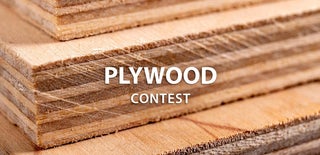Introduction: Plywood Plank Ceiling
Stop reading and look up. Are you looking up? Wait a minute, are you outside?
Okay, go inside, sit-down in your hallway and look up. Hustle up!
Are you looking up? That's called a ceiling and I am going to show you how I covered mine with plywood planks.
Supplies
Shiplap is super trendy now, but it actually refers to the cut of the board. These boards have things called rabbets on each end so they fit together to keep water out. Planks on the other hand can be made from several different wood sources and just stack together on top of each other. Planks don't perfectly fit together like shiplap, so they don't look as nice, but shiplap is a lot more expensive. If you're a baller: buy the shiplap, because ballers: ball! If you're not a baller: samesies! I used plywood.
Sheets of 4mm plywood are under $7 in Japan and I needed to buy 6. The only troublesome part was cutting the sheets of plywood into planks.
Supplies
-4mm plywood cut in 10cm planks. (furring and planks)
-Ceiling sealer
-Screws
-Cemedime Super XG glue
-Watco oil stain
Step 1: Before Pics
This ceiling is actually a false ceiling which is just a fitted ceiling that hangs below the original ceiling of the hallway suspended by a wooden frame. The original ceiling is the bottom of the second floor and Shaquille O'Neal isn't visiting any time soon, so there's no need to have the ceiling that high. It's high too. Like a Seth Rogan-Snoop Dogg sleepover high. I just added the plywood planks to the already build false ceiling frame.
Step 2: Removing the Wallpaper
When removing wallpaper, the paper itself comes off easily, but the backing is challenging to remove. It's a challenging nightmare. If wallpaper backing was a person, they'd be the Joker. I put on my batsuit and removed the backing with a 50/50-vinegar/ water solution. The entire house smelled like a pickle factory.
Make sure you cover the floor to protect it from the wallpaper backing. Spraying it makes it easy to scrape off, but it also makes the glue sticky again and the paper will dry to the floor.
Scraping off wallpaper backing IS as fun as it looks kids!
Pee-Wee Herman just rang my doorbell and asked for a pickle.
I did the ceiling in sections, stopping to seal. I used a water-based ceiling sealer with moisture resistant, anti-fungus and algae resistance properties.
Step 3: The First Section
I used thin 4mm plywood for the furring and planks. Furring acts as a nailer for the planks and I used thin plywood, because I didn't want to lose too much height in the hallway and the thin plywood is light, so it's easy to glue. I used Cemedime Super XG to glue the planks to the furring. It's almost like contact cement and bonds in about 1 minute. I also used screws on the ends of the planks.
*The thinner the planks, the more chance they'll warp or bow. The furring is important and you want as much of the plank in contact with it as possible.
"Why glue?"
I didn't want any visible nail or screw heads.
"Why furring?"
I didn't want to glue the planks directly to the ceiling.
I attached the furring across the wooden ceiling frame with screws.
Paint or stain?
I stained the plank with an medium brown oil stain. After this first section, I starting staining the planks after they were up. I wanted a lighter color, but changed my mind once I saw it.
It's as easy as that!
Step 4: Picture Time
I used 1x4's for the faux beams. These are attached to the ceiling frame. It's better to paint them, before putting them up and the screw holes are just filled with wood filler, sanded and painted. I also trimmed around the hallway.
So, that's it! Pretty awesome for a stack of 4mm plywood.
The tedious parts:
-cutting the plywood
-glueing it to the furring
The Cemedime glue works like contact cement, but you need to apply pressure for about 90 seconds. Rough on the arms after getting a couple up. Next time, I’d cut a length of wood to hold it up.

Runner Up in the
Plywood Contest













